Rice is grown in almost every country, and it is the most important crop in the world. Cambodia is no exception. Rice plays a vital role in the country’s economy and culture. If you’re thinking about starting a rice farm in Cambodia, there are a few things you need to know. This blog post will cover everything from business planning to cultivation practices and yield. We’ll also touch on some of Cambodia’s most popular rice varieties. So if you’re ready to learn more about how to start your rice farm in Cambodia, read on!
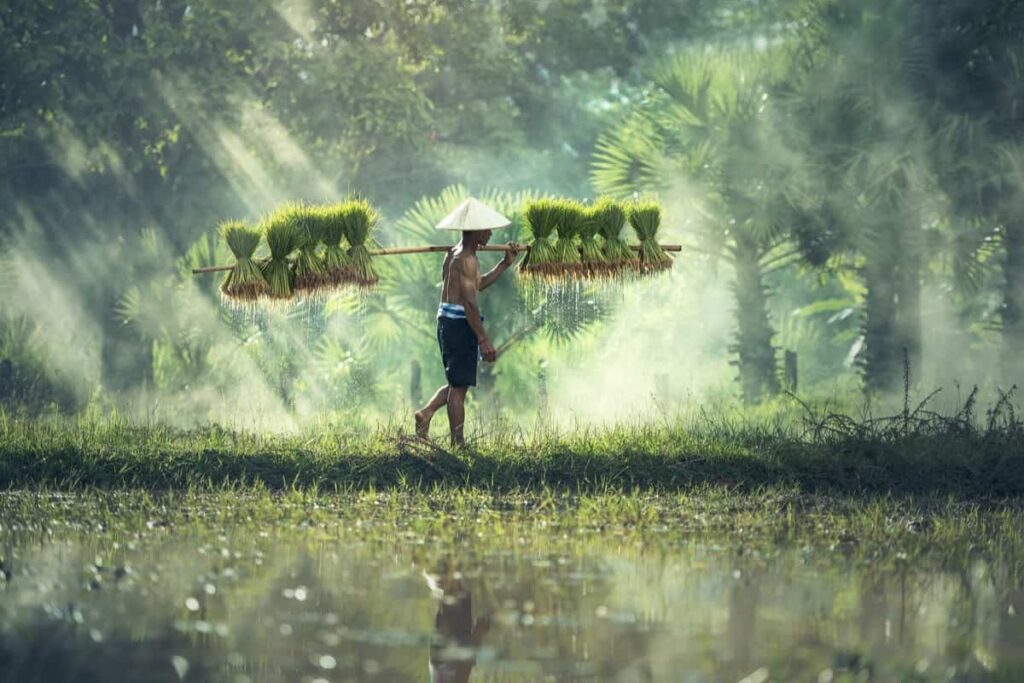
How to start rice farming in Cambodia
What is Rice Farming?
Rice farming in Cambodia is a labor-intensive process that involves planting, watering, and harvesting the crop. The most common rice type grown in Cambodia is jasmine rice, a long-grain variety commonly used in Asian cuisine. Other popular types of rice grown in Cambodia include basmati and sticky rice. The first step in starting a rice farm in Cambodia is to obtain the necessary land. The land should be flat and have access to water for irrigation.
Once the land has been secured, the next step is to prepare the soil for planting. This includes plowing, leveling the land, and adding any necessary amendments, such as fertilizer. Once the soil is ready, it’s time to plant the rice seeds. This is typically done by hand, though some farmers may use machines to plant the seeds. After planting, the seedlings must be watered regularly and protected from pests and diseases.
As the seedlings grow, they need to be thinned out so that only the healthiest plants remain. The thinning process helps ensure that each plant has enough space to grow properly and produce a good yield. Once the plants are mature, they will need to be harvested. This is typically done by hand, though some farmers may use machines to harvest their crops. After harvesting, the rice grains will need to be dried before they can be stored or sold.
In case you missed it: High Yield Hybrid Paddy/Rice Varieties in India: For Rabi and Kharif Seasons

Rice varieties in Cambodia
There are many different rice varieties cultivated in Cambodia. The most popular varieties are jasmine, basmati, and long-grain rice. Jasmine rice is fragrant rice commonly used in Southeast Asian cuisine. Basmati rice is a long-grain, aromatic rice popular in Indian and Pakistani cuisine. Long-grain Rice is a type of rice that has a longer grain than other types of rice. It is often used in stir-fries and other dishes where the grains need to hold together.
Cambodia also produces a lot of glutinous rice, a sticky Rice often used in desserts or as an ingredient in savory dishes. Glutinous Rice is not as widely available outside of Cambodia, so it can be difficult to find if you’re not looking specifically for it. When choosing a rice variety for your farm, it’s important to consider what crops you want to grow and what your soil type is like.
Different types of rice require different growing conditions, so it’s important to do your research before deciding on a particular variety. Once you’ve chosen a variety, you’ll need to purchase seed from a reputable supplier. Make sure to get enough seed to plant your entire field and some extra in case of losses during planting or harvest time.
What is the process for Rice cultivation in Cambodia?
Cambodia is a country located in the Mekong River basin in Southeast Asia. The country has a tropical climate with two main seasons: the rainy season from May to October and the dry season from November to April. Rice is the staple crop in Cambodia and is cultivated throughout the country. The process of rice cultivation in Cambodia includes plowing, planting, watering, weeding, and harvesting.
- Plowing: Plowing is done with a water buffalo or tractor. The field is plowed several times before planting to loosen the soil and prepare it for planting.
- Planting: Planting occurs during the rainy season when there is enough moisture in the soil. Seedlings are transplanted into the field using a dibble stick. Watering: Fields are watered by rain during the rainy season and by irrigation during the dry season. Weeding: Weeds are removed by hand or with a hoe. Harvesting: Harvesting takes place four to six months after planting, depending on the variety of rice being grown. The rice stalks are cut using a sickle and threshed to remove the grains from the straw.
In case you missed it: Common Factors That Can Improve Rice Yield Rate in the US
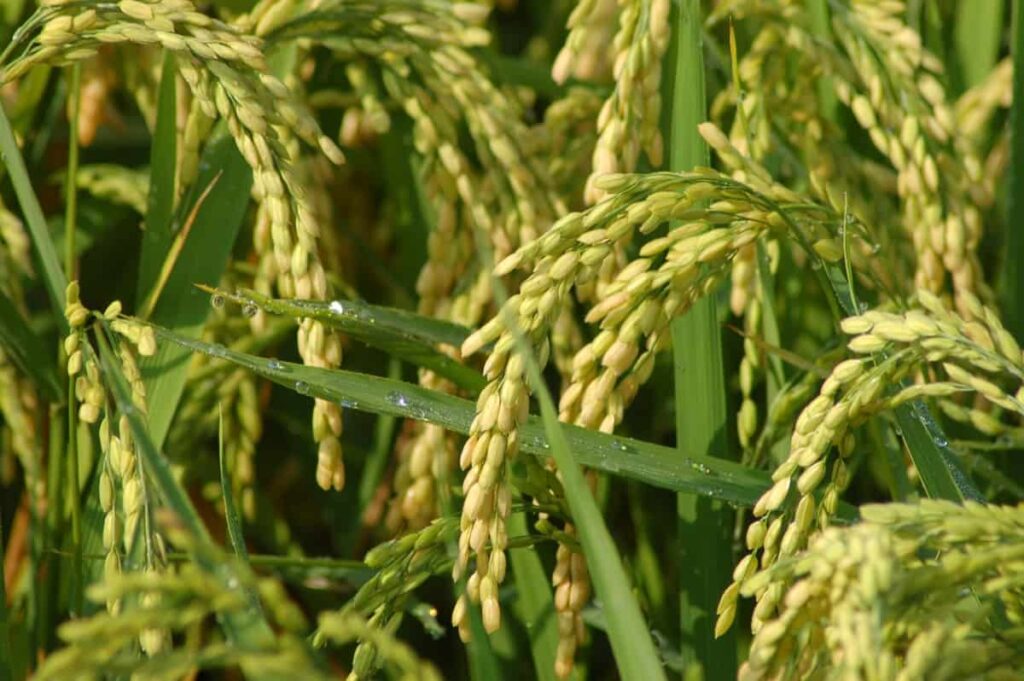
The business plan for Rice farming in Cambodia
Starting a rice farm in Cambodia is a great way to produce a staple crop in high demand. Many different rice varieties can be grown in Cambodia, and the cultivation practices and yield will vary depending on the variety chosen. They create a comprehensive business plan before starting any agricultural venture, especially for rice farming.
Several key points should be considered when developing a business plan for rice farming in Cambodia. First, it is important to research the different types of rice that can be grown in the country. Second, inputs such as seed, fertilizer, and labor costs must be estimated. Third, a sales and marketing plan must be created to sell the rice crop. Finally, it is important to consider the risk factors associated with starting a new agricultural venture.
Once the business plan is developed, it is time to choose the type of rice grown on the farm. Many varieties of rice can be cultivated in Cambodia, each with unique characteristics. Some popular varieties include jasmine rice, basmati rice, and brown rice. Once the type of rice has been selected, it is time to start preparing the land for cultivation. The first step in preparing the land for cultivation is to clear any trees or shrubs that may be present. Next, the soil must be plowed and leveled.
The cultivation practices for Rice farming in Cambodia
Several cultivation practices are followed for rice farming in Cambodia. The most important among these is using the correct variety of seeds. The next important step is to clear the land of all vegetation and debris. This is usually done by burning the land. Once the land is cleared, it is plowed and leveled using a tractor. The next step is to wet the field by flooding it with water.
This helps in softening the soil and also kills any pests or diseases that might be present in the soil. After the field has been flooded, it is drained and allowed to dry for a few days. Once the field is dry, seedlings are transplanted into it. This is usually done by hand, as mechanized equipment cannot be used in such small fields. The seedlings are transplanted at a spacing of 20 cm x 20 cm.
In case you missed it: Key Rules for Kitchen Gardening: How to Start from Scratch, Plan, the Principles, Ideas, and Tips
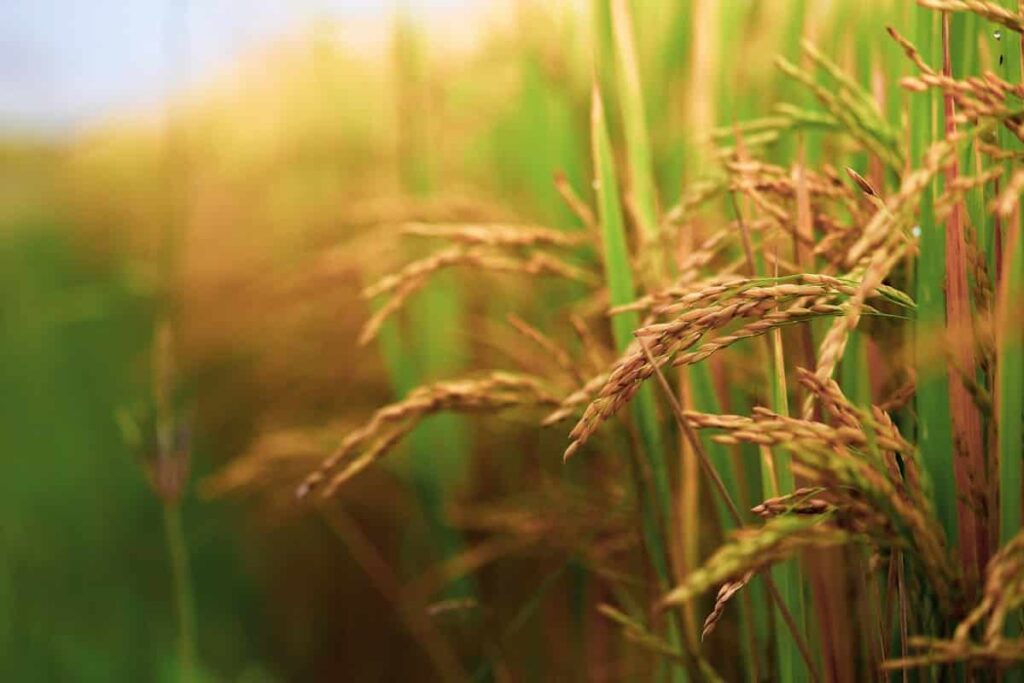
After transplanting, the fields are again flooded with water and kept moist throughout the growing season. Fertilizers are applied to the fields at regular intervals to ensure good growth of the plants. Harvesting of rice crops takes place after 4-5 months from transplanting. The crop is cut using sickles and threshed to remove the grains from the straws. The grain is then winnowed to remove any impurities and finally stored for consumption or sale.
The yield of Rice farming in Cambodia
The yield of rice farming in Cambodia depends on many factors, including the variety of rice planted, the cultivation practices used, and the weather conditions during the growing season. Rice is a staple crop in Cambodia, and it can produce enough rice to meet its needs. Rice production has recently increased thanks to improved farming methods and increased investment in the sector.
The average yield of rice farms in Cambodia is around 3.5 tons per hectare. However, yields can vary greatly from farm to farm, depending on the abovementioned factors. For example, farms that use modern irrigation systems and employ good agricultural practices can achieve yields of up to 6 tons per hectare. Weather conditions are also a major factor affecting yields. For instance, drought can lead to lower yields, while excessive rain can cause problems with flooding.
Despite the challenges, rice farmers in Cambodia have been able to achieve consistent results by using innovative techniques and adopting good husbandry practices. With continued investment and support from the government, Cambodia will likely continue to be a main player in the global rice market.
Alternatives to Rice Farming in Cambodia
In Cambodia, many different types of rice are grown. Each type of rice has its unique flavor and texture, making it perfect for various dishes.
- White rice is the popular type in Cambodia and is often used for steamed dishes or as a base for other ingredients.
- Jasmine rice is another type of white rice that is commonly used in Cambodian cuisine. This type of rice has a slightly floral flavor and a softer texture.
- Basmati rice is a long-grain brown rice typically used in Indian cuisine.
- Red cargo rice is a medium grain red rice with a nutty flavor and slightly sticky texture. This type of rice is often used in fried dishes or as a side dish.
- Black sticky rice is purple and has a sweet flavor. It’s often used in desserts or as an ingredient in other sweet dishes.
In case you missed it: Agricultural Biotechnology in India: Role, Examples, Jobs, Salary, Courses, and Colleges
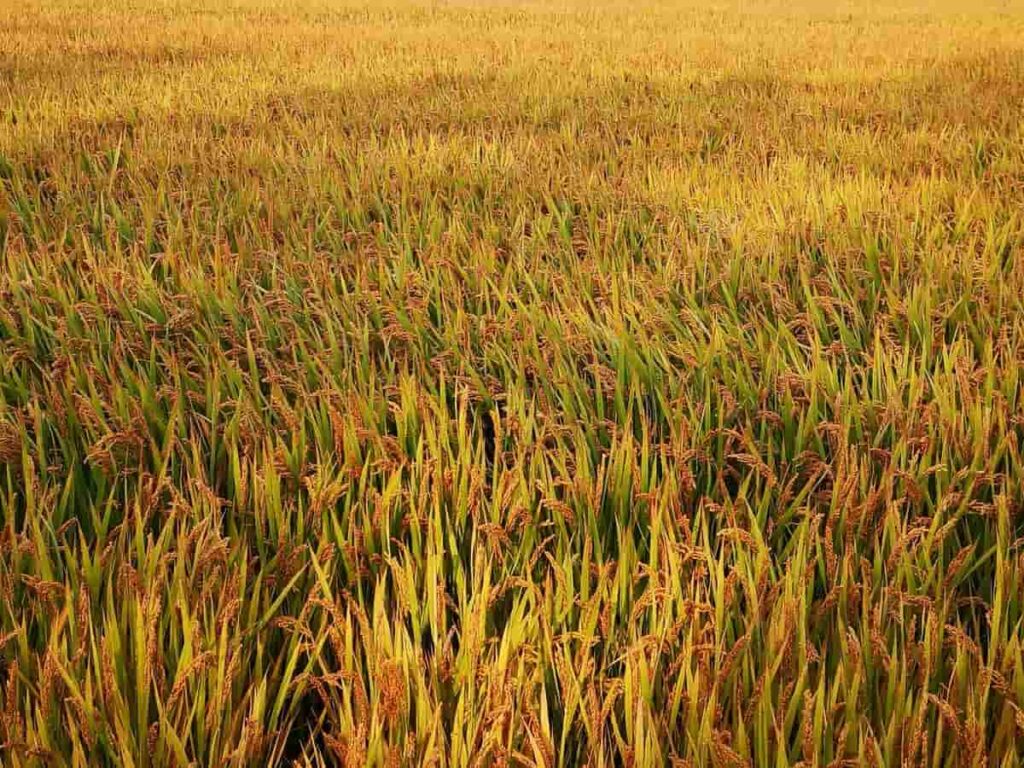
How is Rice grown in Cambodia?
In Cambodia, most rice is grown in the wet season, with seedlings transplanted into paddies in May or June. The average farm size is about 0.6 hectares. The main rice-growing areas are in the north and northwest of the country, where the climate is favorable for irrigated rice cultivation. However, most of the rice grown in Cambodia is rainfed, and only about 10% of the area under rice cultivation is equipped for irrigation. In general, upland areas are better suited for rainfed production, while lowland areas are better suited for irrigated production.
Rice cultivation practices in Cambodia vary depending on whether the crop is rainfed or irrigated. For rainfed crops, farmers typically wait until the rains have started before transplanting seedlings into the field. This ensures that there will be enough water available for the crop during its critical growth stages. For irrigated crops, on the other hand, farmers can transplant seedlings at any time of year as long as there is enough water available for irrigation.
The main rice varieties grown in Cambodia are japonica and indica types. Japonica varieties comprise about 60% of the total area under rice cultivation, while indica varieties make up the remaining 40%. Among japonica varieties, kongngam and kompongsom are the most widely cultivated. Kongngam is a medium-grain variety that is popular among Cambodian farmers.
What type of rice is grown in Cambodia?
Cambodia is a country located in Southeast Asia. The rice grown in Cambodia is a tropical variety of rice, different from the rice grown in other parts of the world. The climate in Cambodia is hot and humid, with a lot of rainfall. This makes it ideal for growing rice. The two main types of rice grown in Cambodia are Jasmine rice and Basmati rice. Jasmine rice is the most popular type in Cambodia.
It has a long grain and a slightly sweet taste. Basmati rice is also a popular type of Rice in Cambodia. It has a long grain and a nutty taste. Cambodia produces both White Rice and Brown Rice. White Rice is the most common rice type consumed in Cambodia. Cambodia exports white rice and brown rice to other countries worldwide.
How much Rice gets from 1 acre of land in Cambodia?
In Cambodia, you can expect to yield about 3.5 tons of rice per acre from the paddy field. The average size of a Cambodian farm is 1-3 hectares. In terms of production, Cambodia is ranked 12th in the world for Rice production. For the 2019/2020 season, Cambodia’s total area harvested was 1.61 million hectares, with a total production of 7.85 million metric tons (FAOSTAT).
Why is Cambodia Rice the best?
Cambodia rice is the best for many reasons. First, the climate in Cambodia is ideal for growing rice. The country has two main seasons – the wet and the dry seasons- perfect for growing rice. The wet season provides enough water for the rice to grow, while the dry season ensures that the rice does not rot. Second, Cambodia has a long tradition of rice farming. The country has been growing rice for centuries, and as a result, Cambodian farmers have a lot of experience and expertise in cultivating this crop.
They know exactly what conditions are necessary for optimum growth and yield and have passed this knowledge down from generation to generation. Third, Cambodian farmers use traditional methods of cultivation that are gentle on the environment. They do not use harsh chemicals or pesticides and rotate their crops to ensure that the soil remains healthy. This results in healthier plants that can resist disease and pests.
In case you missed it: How to Start an Organic Vegetable Farming in Telangana: Business Plan, Crops, and Subsidy
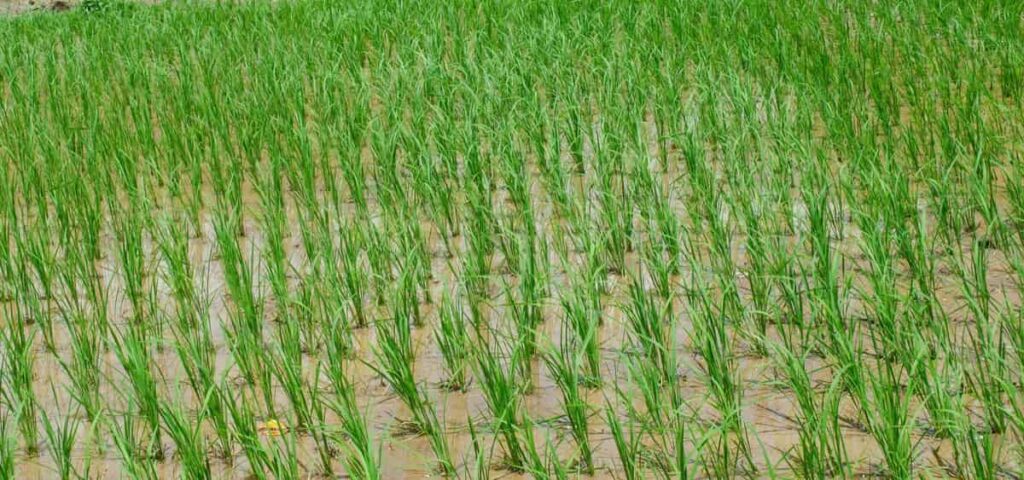
Fourth, Cambodia produces high-quality products. Cambodian Rice is known for its excellent flavor and texture, making it the main choice among chefs and home cooks. It is also relatively inexpensive, making it a great value for your money. Fifth, Cambodia is one of the largest organic rice suppliers, so you can be sure you’re getting a product free of harmful chemicals and pesticides.
Conclusion
Starting a rice farm in Cambodia is a great way to get involved in the agricultural sector of this rapidly developing country. With the right business plan, rice varieties, and cultivation practices, you can set up a successful operation to provide a good income for you and your family.
- Crops Grown in Summer Season: Best Choices for Summer Gardening
- Organic Pest Control for Tomato Farming
- How to Maximize Sheep Farming Profit
- Broccoli Varieties: Choosing the Right Cultivars for Your Farm
- How to Raise Pigs in Your Own Backyard: A Comprehensive Guide
- Budget Friendly Sheep Shed Ideas: Cheap and Low-Cost Tips
- How Much Do Cattle Farmers Make: Revenue Streams in Cattle Farming
- Management Pests and Diseases in Your Cotton Field
- Sheep Farming Business Plan for Beginners
- Aquaponic Farming at Home: A Step-By-Step Guide
- Profitable Village Farming Business Ideas in 2024
- High-Yield Aquaculture: Fast-Growing Fish for Farming
- Effective Fish Pond Construction Techniques for Beginners
- Irrigation and Water Management in Pineapple Farming
- Blossom to Harvest: Mastering Flowering and Pollination in Papaya Farming
- Pig Fattening Essentials: From Selection to Sale for Beginners
- Raising Wagyu Cattle: A Complete Guide for Premium Beef Production
- Soil Types and Their Water Holding Capacity
- Optimizing Irrigation Schedules for Coconut Groves for Enhanced Yield
- Espresso Your Garden: Coffee Grounds for Healthier Acid-Loving Plants
- The Best Soil Mix for Snake Plants: How to Mix Your Own Snake Plant Soil
- Green Thumb Success: Expert Tips for Cultivating Greenhouse Beans All Year Round
- Bloom All Year Round: The Ultimate Guide to Indoor Hyacinth Care
- Eco-Friendly Gardening: How to Make Liquid Fertilizer from Kitchen Waste
- Ultimate Guide to Grow Anise in Pots: Explore Seed Propagation to Harvesting
- Guide to Raising Chester White Pigs: Discover Breed Facts to Growth Management
- Mastering the Elegance: The Ultimate Guide to Weeping Cherry Tree Care, Planting, and Maintenance
- Ultimate Guide to Planting Garlic in Grow Bags: Growing Strategies for Beginners
- How to Fix Spider Plant Leaf-Related Problems: Natural and Organic Remedies
- 10 Reasons Why Your Tulsi Plant is Shedding Leaves: Home Remedies and Solutions
- Optimizing Growth and Yield: The Advantages of Palm Bunch Ash Fertilizer
- Utilizing Neem Oil Extract as a Natural Pesticide for Hydrangea
- From Soil to Harvest: Various Ways in Which Farmers Can Use AI Tools
- Steps to Encourage and Induce Citrus Flowers: A Comprehensive Guide
- How to Fix Snake Plant Leaf-Related Issues: Natural and Organic Remedies
- Transform Your Garden into a Fragrant Oasis with Raat Ki Rani (Night Blooming Jasmine)
